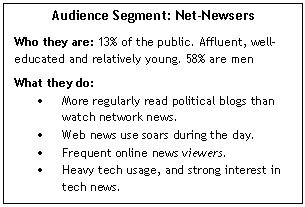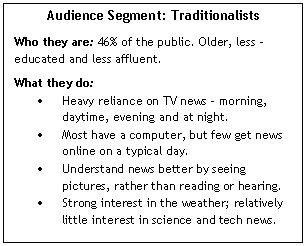Overview
For more than a decade, the audiences for most traditional news sources have steadily declined, as the number of people getting news online has surged. However, today it is not a choice between traditional sources and the internet for the core elements of today’s news audiences.
A sizable minority of Americans find themselves at the intersection of these two long-standing trends in news consumption. Integrators, who get the news from both traditional sources and the internet, are a more engaged, sophisticated and demographically sought-after audience segment than those who mostly rely on traditional news sources. Integrators share some characteristics with a smaller, younger, more internet savvy audience segment – Net-Newsers – who principally turn to the web for news, and largely eschew traditional sources. (For a complete description of how the news audience segments are classified, see pg. 45.)
 Like web-oriented news consumers, Integrators are affluent and highly educated. However, they are older, on average, than those who consider the internet their main source of news. Overall, Integrators spend more time with the news on a typical day than do those who rely more on either traditional or internet sources; far more enjoy keeping up with the news a lot than in any other news segment.
Like web-oriented news consumers, Integrators are affluent and highly educated. However, they are older, on average, than those who consider the internet their main source of news. Overall, Integrators spend more time with the news on a typical day than do those who rely more on either traditional or internet sources; far more enjoy keeping up with the news a lot than in any other news segment.
Integrators also are heavier consumers of national news – especially news about politics and Washington – and are avid sports news consumers. Television is their main news source, but more than a third cite the internet as their primary source of news during the day. This reflects the fact that a relatively large proportion of Integrators log on to the internet from work (45%).
The 2008 biennial news consumption survey by the Pew Research Center for the People & the Press was conducted by telephone – including both landline phones and cell phones – from April 30 to June 1 among 3,612 adults nationwide. It finds four distinct segments in today’s news audience: Integrators, who comprise 23% of the public; the less populous Net-Newsers (13%); Traditionalists – the oldest (median age: 52) and largest news segment (46% of the public); and the Disengaged (14%) who stand out for their low levels of interest in the news and news consumption.
Net-Newsers are the youngest of the news user segments (median age: 35). They are affluent and even better educated than the News Integrators: More than eight-in-ten have at least attended college. Net-Newsers not only rely primarily on the internet for news, they are leading the way in using new web features and other technologies. Nearly twice as many regularly watch news clips on the internet as regularly watch nightly network news broadcasts (30% vs. 18%).
 This web-oriented news segment, perhaps more than the others, underscores the challenges facing traditional news outlets. Fewer than half (47%) watch television news on a typical day. Twice as many read an online newspaper than a printed newspaper on a typical day (17% vs. 8%), while 10% read both.
This web-oriented news segment, perhaps more than the others, underscores the challenges facing traditional news outlets. Fewer than half (47%) watch television news on a typical day. Twice as many read an online newspaper than a printed newspaper on a typical day (17% vs. 8%), while 10% read both.
However, Net-Newsers do rely on some well known traditional media outlets. They are at least as likely as Integrators and Traditionalists to read magazines such as The New Yorker and The Atlantic, and somewhat more likely to get news from the BBC.
 Fully 82% of Net-Newsers get news during the course of the day, far more than the Traditionalists and the Disengaged, and slightly more than the Integrators. Nearly all who get news at this time go online for information (92%). Yet they do tap traditional sources at other times of the day; nearly two-thirds get news late in the evening and of these, more rely on television news than the internet.
Fully 82% of Net-Newsers get news during the course of the day, far more than the Traditionalists and the Disengaged, and slightly more than the Integrators. Nearly all who get news at this time go online for information (92%). Yet they do tap traditional sources at other times of the day; nearly two-thirds get news late in the evening and of these, more rely on television news than the internet.
Despite sweeping changes in the news landscape, Traditionalists remain the largest segment of the overall news audience. Compared with the Integrators and Net-Newsers, Traditionalists are downscale economically – 43% are not employed and 60% have no more than a high school education.

Television dominates as the favored news source among Traditionalists. And at each time of the day – whether morning, daytime, dinner hour, or late at night – overwhelming majorities who get news at these times cite television as their main source. Unlike the news Integrators, or those who mostly get news from the web, most Traditionalists say that seeing pictures and video, rather than reading or hearing the facts, gives them the best understanding of events.
Most Americans fall into the three core news audiences – Integrators, Traditionalists, or Net-Newsers. The fourth group – the Disengaged – are very much bystanders when it comes to news consumption. They are less educated on average than even the Traditionalists and exhibit extremely low interest in – and knowledge of – current events. Just 55% of the Disengaged get any news on a typical day, and just 20% know that the Democrats have a majority in the House of Representatives.
Trends in News Consumption
The diversity of news audience segments identified reflects the long-term changes in news consumption observed in the biennial survey, conducted April 30-June 1 among 3,615 Americans.
 Since the early 1990s, the proportion of Americans saying they read a newspaper on a typical day has declined by about 40%; the proportion that regularly watches nightly network news has fallen by half.
Since the early 1990s, the proportion of Americans saying they read a newspaper on a typical day has declined by about 40%; the proportion that regularly watches nightly network news has fallen by half.
These trends have been more stable in recent years, but the percentage saying they read a newspaper yesterday has fallen from 40% to 34% in the last two years alone. Newspapers would have suffered even greater losses without their online versions. Most of the loss in readership since 2006 has come among those who read the print newspaper; just 27% say they read only the print version of a daily newspaper yesterday, down from 34% in 2006.
The television news audience, by contrast, has generally remained stable since 2006, and the proportion regularly watching cable news in particular has increased (from 34% to 39%). The appeal of television news is seen in the large percentages of the news segments – particularly Integrators – that continue to watch: A majority of Integrators (56%) get news online on a typical day while an even larger share (66%) got news from television.
Cable news draws substantial numbers of viewers among Integrators and Net- Newsers. More than four-in-ten Net-Newsers (43%) regularly watch cable news, far more than the proportion that regularly watches network or local news. A majority of Integrators also regularly tunes in to cable news (53%); by comparison, just 37% say they regularly watch one of the nightly network news broadcasts.
Notably, radio news also is an important element in Integrators’ news diet. Nearly half of Integrators (46%) listen to news on the radio during a typical day. While the internet is the main news source for Integrators during the course of the day, about as many in this segment rely on radio news as TV news during the day (32% radio vs. 36% TV news).
Online News Still Growing
Since 2006, the proportion of Americans who say they get news online at least three days a week has increased from 31% to 37%. About as many people now say they go online for news regularly (at least three days a week) as say they regularly watch cable news (39%); substantially more people regularly get news online than regularly watch one of the nightly network news broadcasts (37% vs. 29%).
Since 2006, daily online news use has increased by about a third, from 18% to 25%. However, as the online news audience grows, the educational divide in online news use – evident since the internet’s early days in the mid-1990s – also is increasing. Currently, 44% of college graduates say they get news online every day, compared with just 11% of those with a high school education or less.
Net-Newsers and Integrators take advantage of a range of web features to get the news. Roughly four-in-ten (39%) Net-Newsers – and about a third of Integrators (32%) – have gotten a news story emailed to them in the past week. And while 30% of Net-Newsers regularly watch news online, 19% regularly listen to news on the web.
Net-Newsers and Integrators also rely on news and political blogs as a part of their news diet. Roughly a quarter of Net-Newsers (26%) and somewhat fewer Integrators (19%) say they regularly read blogs on politics or current events. Overall, only 10% of the public regularly reads political and news blogs.
Other Key Findings:

- In spite of the increasing variety of ways to get the news, the proportion of young people getting no news on a typical day has increased substantially over the past decade. About a third of those younger than 25 (34%) say they get no news on a typical day, up from 25% in 1998.
- A slim majority of Americans (51%) now say they check in on the news from time to time during the day, rather than get the news at regular times. This marks the first time since the question was first asked in 2002 that most Americans consider themselves “news grazers.”
- Social networking sites are very popular with young people, but they have not become a major source of news. Just 10% of those with social networking profiles say they regularly get news from these sites.
- As in past news consumption surveys, the audiences for specific cable news outlets remain divided along political lines. Currently 51% of regular CNN viewers are Democrats, up from 45% two years ago. Nearly four-in-ten regular Fox News viewers are Republicans (39%), about the same as in 2006.
- Regular readers of magazines such as The New Yorker, The Atlantic and Harper’s Magazine stand out for their high level of political knowledge. Nearly half (47%) answered three political knowledge questions correctly – the highest percentage of any news audience.
- Overall, 15% of Americans say they have a smart phone, such as an iPhone or a Blackberry. More than a third of smart phone owners (37%) say they get news from these devices.
- Believability ratings for national news organizations remain very low. If anything, believability ratings for major online news outlets – including news aggregators such as Google News and AOL News – are lower than for major print, cable and broadcast outlets.
- Though the audience for nightly network news broadcasts are smaller than they were a decade ago, regular viewers of these broadcasts are loyal. Nearly seven-in-ten (69%) say they would miss these broadcasts a lot if they were no longer available.



